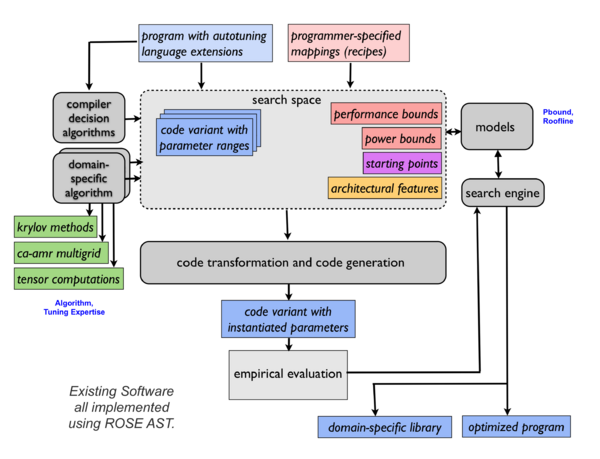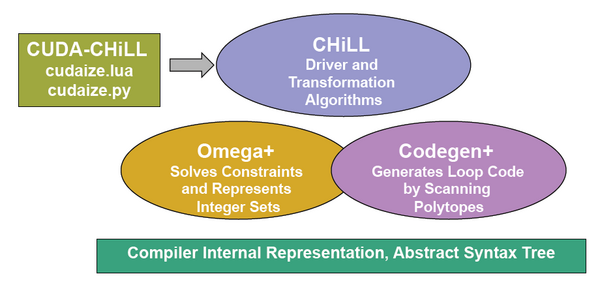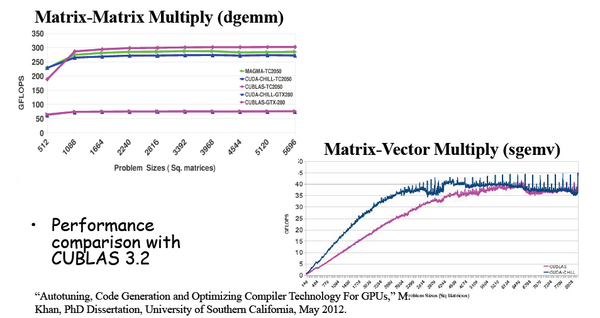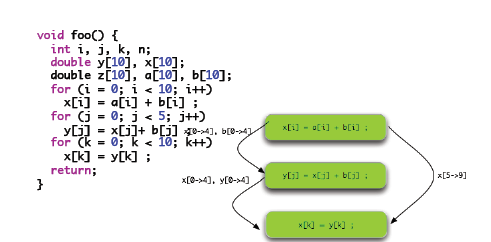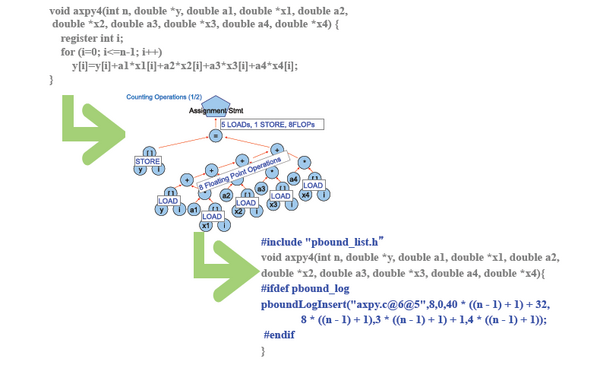X-TUNE: Difference between revisions
From Modelado Foundation
No edit summary |
No edit summary |
||
| (2 intermediate revisions by the same user not shown) | |||
| Line 4: | Line 4: | ||
| imagecaption = | | imagecaption = | ||
| team-members = [http:///www.utah.edu/ U. of Utah], [http://www.anl.gov/ ANL], [http://www.lbl.gov/ LBNL], [http://www.isi.edu/ USC/ISI] | | team-members = [http:///www.utah.edu/ U. of Utah], [http://www.anl.gov/ ANL], [http://www.lbl.gov/ LBNL], [http://www.isi.edu/ USC/ISI] | ||
| pi = Mary Hall | | pi = [[Mary Hall]] | ||
| co-pi = Paul Hovland (ANL), Samuel Williams (LBNL), Jacqueline Chame (USC/ISI) | | co-pi = Paul Hovland (ANL), Samuel Williams (LBNL), Jacqueline Chame (USC/ISI) | ||
| website = [http://ctop.cs.utah.edu/x-tune/ http://ctop.cs.utah.edu/x-tune/] | | website = [http://ctop.cs.utah.edu/x-tune/ http://ctop.cs.utah.edu/x-tune/] | ||
| Line 142: | Line 142: | ||
=== Application Signatures + Architecture === | === Application Signatures + Architecture === | ||
[[File:XTUNE-Pbound-Example. | [[File:XTUNE-Pbound-Example.png|600px]] | ||
== How will modeling be used? == | == How will modeling be used? == | ||
| Line 167: | Line 167: | ||
'''Multigrid and Adaptive Mesh Refinement''' | '''Multigrid and Adaptive Mesh Refinement''' | ||
[[File:XTUNE-Multigrid. | [[File:XTUNE-Multigrid.jpg|right|200px]] | ||
* Some regions of the domain may require finer fidelity than others | * Some regions of the domain may require finer fidelity than others | ||
* In Adaptive Mesh Refinement, we refine those regions to a higher resolution in time and space | * In Adaptive Mesh Refinement, we refine those regions to a higher resolution in time and space | ||
Latest revision as of 05:04, July 10, 2023
| X-TUNE | |
|---|---|
 | |
| Team Members | U. of Utah, ANL, LBNL, USC/ISI |
| PI | Mary Hall |
| Co-PIs | Paul Hovland (ANL), Samuel Williams (LBNL), Jacqueline Chame (USC/ISI) |
| Website | http://ctop.cs.utah.edu/x-tune/ |
| Download | {{{download}}} |
Autotuning for Exascale or X-TUNE - Self-Tuning Software to manage Heterogeneity
Team Members
- University of Utah: Mary Hall (Lead PI)
- Argonne National Laboratory (ANL): Paul Hovland, Stefan Wild, Krishna Narayanan, Jeff Hammond
- Lawrence Berkeley National Laboratory (LBNL): Sam Williams, Lenny Oliker, Brian van Straalen
- University of Southern California: Information Science Institute (USC/ISI): Jacqueline Chame
What is Autotuning?
Definition:
- Automatically generate a “search space” of possible implementations of a computation
- A code variant represents a unique implementation of a computation, among many
- A parameter represents a discrete set of values that govern code generation or execution of a variant
- Measure execution time and compare
- Select the best-performing implementation (for exascale, tradeoff between performance/energy/reliability)
Key Issues:
- Identifying the search space
- Pruning the search space to manage costs
- Off-line vs. on-line search
Three Types of Autotuning Systems
- Autotuning libraries
- Library that encapsulates knowledge of its performance under different execution environments
- Dense linear algebra: ATLAS, PhiPAC
- Sparse linear algebra: OSKI
- Signal processing: SPIRAL, FFTW
- Application-specific autotuning
- Active Harmony provides parallel rank order search for tunable parameters and variants
- Sequoia and PetaBricks provide language mechanism for expressing tunable parameters and variants
- Compiler-based autotuning
- Other examples: Saday et al., Swany et al., Eignenmann et al.
- Related concepts: iterative compilation, learning-based compilation
X-TUNE Goals
A unified autotuning framework that seamlessly integrates programmer-directed and compiler-directed autotuning
- Expert programmer and compiler work collaboratively to tune a code
- Unlike previous systems that place the burden on either programmer or compiler
- Provides access to compiler optimizations, offering expert programmers the control over optimization they so often desire
- Design autotuning to be encapsulated in domain-specific tools
- Enables less-sophisticated users of the software to reap the benefit of the expert programmers’ efforts
- Focus on Adaptive Mesh Refinement Multigrid (Combustion Co-Design Center, BoxLib, Chombo) and tensor contractions (TCE)
Project Impact
X-TUNE Structure
Autotuning Language Extensions
- Tunable Variables
- An annotation on the type of a variable (as in Sequoia)
- Additionally, specify range, constraints and a default value
- Computation Variants
- An annotation on the type of a function (as in PetaBricks)
- Additionally, specify (partial) selection criteria
- Multiple variants may be composed in the same execution
Separate mapping description captures architecture-specific aspects of autotuning.
Compiler-Based Autotuning
- Foundational Concepts
- Identify search space through a high-level description that captures a large space of possible implementations
- Prune space through compiler domain knowledge and architecture features
- Provide access to programmers with transformation recipes, or recipes generated automatically by compiler decision algorithm
- Uses source-to-source transformation for portability, and to leverage vendor code generation
- Requires restructuring of the compiler
CHiLL Implementation
Transformation Recipes for Autotuning
Incorporate the Best Ideas from Manual Tuning
Compiler + Autotuning can yield comparable and even better performance than manually-tuned libraries
Pbound: Performance Modeling for Autotuning
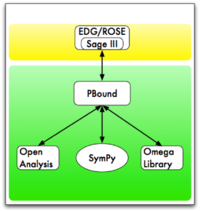
- Performance modeling increases the automation in autotuning
- Manual transformation recipe generation is tedious and error-prone
- Implicit models are not portable across platforms
- Models can unify programmer guidance and compiler analysis
- Programmer can invoke integrated models to guide autotuning from application code
- Compiler can invoke models during decision algorithms
- Models optimize autotuning search
- Identify starting points
- Prune search space to focus on most promising solutions
- Provide feedback from updates in response to code modifications
Reuse Distance and Cache Miss Prediction
Reuse distance
- For regular (affine) array references
- Compute reuse distance, to predict data footprints in memory hierarchy
- Guides transformation and data placement decisions
Cache miss prediction
- Use to predict misses
- Assuming fully associative cache with n lines (optimistic case), a reference will hit if the reuse distance d<n
Application Signatures + Architecture
How will modeling be used?
- Single-core and multicore models for application performance will combine architectural information, user-guidance, and application analysis
- Models will be coupled with decision algorithms to automatically generate CHiLL transformation recipes
- Input: Reuse Information, Loop Information etc.
- Output: Set of transformation scripts to be used by empirical search
- Feedback to be used to refine model parameters and behavior
- Small and large application execution times will be considered
Example: Stencils and Multigrid
- Stencil performance bound, when bandwidth limited:
Performance (gflops) <= stencil flops * STREAM bandwidth / grid size
- Multigrid solves Au=f by calculating a number of corrections to an initial solution at varying grid coarsenings (“V-cycle”)
- Each level in the v-cycle: perform 1-4 relaxes (~stencil sweeps)
- Repeat multiple v-cycles reducing the norm of the residual by an order of magnitude each cycle
Multigrid and Adaptive Mesh Refinement
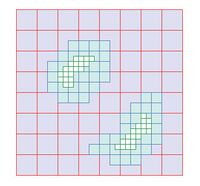
- Some regions of the domain may require finer fidelity than others
- In Adaptive Mesh Refinement, we refine those regions to a higher resolution in time and space
- Typically, one performs a multigrid “level solve” for one level (green, blue, red) at a time
- Coarse-fine boundaries (neighboring points can be at different resolutions) complicate the calculation of the RHS and ghost zones for the level
- Each level is a collection of small (323 or 643) boxes to minimize unnecessary work
- These boxes will be distributed across the machine for load balancing (neighbors are not obvious/implicit)
Autotuning for AMR Multigrid
- Focus is addressing data movement, multifaceted:
- Automate fusion of stencils within an operator. Doing so may entail aggregation of communication (deeper ghost zones)
- Extend and automate the communication-avoiding techniques developed in CACHE
- Automate application of data movement-friendly coarse-fine boundary conditions
- Automate hierarchical parallelism within a node to AMR MG codes
- Explore alternate data structures
- Explore alternate stencil algorithms (higher order, …)
- Proxy architectures: MIC, BG/Q, GPUs
- Encapsulate into an embedded DSL approach
Summary and Leverage
- Build integrated end-to-end autotuning, focused on AMR multigrid and tensor contractions
- Language and compiler guidance of autotuning
- Programmer and compiler collaborate to tune a code
- Modeling assists programmer, compiler writer, and search space pruning
- Leverage and integrate with other X-Stack teams
- Our compiler technology all based on ROSE so can leverage from and provide capability to ROSE
- Domain-specific technology to facilitate encapsulating our autotuning strategies
- Collaborate with MIT on autotuning interface
- Common run-time for a variety of platforms (e.g., GPUs and MIC), and supports a large number of potentially hierarchical threads
Products
- Publications
- H. Zhang, A. Venkat, P. Basu and M. Hall, "On Combining Polyhedral and AST Transformations," International Workshop on Polyhedral Compilation Techniques, Jan. 2016.
- P. Basu, "Compiler Optimizations and Autotuning for Stencil Computations and Geometric Multigrid," PhD dissertation, University of Utah, December 2015.
- T. Nelson, "DSLs and Search for Linear Algebra Performance Optimization," PhD dissertation, University of Colorado, December 2015.
- T. Nelson, A. Rivera, M. Hall, P.D. Hovland, E. Jessup and B. Norris, "Generating Efficient Tensor Contractions for GPUs, International Conference on Parallel Processing, Sept., 2015.
- P. Basu, S. Williams, B. V. Straalen, M. Hall, L. Oliker, P. Colella, "Compiler-Directed Transformation for Higher-Order Stencils, International Parallel and Distributed Processing Symposium (IPDPS), 2015.
- A. Rivera. "Using Autotuning for Accelerating Tensor-Contraction on GPUs", Masters thesis, University of Utah, December 2014.
- P. Basu, S. Williams, B. V. Straalen, L. Oliker, M. Hall, ``Converting Stencils to Accumulations for Communication-Avoiding Optimization in Geometric Multigrid, Workshop on Stencil Computations (WOSC), 2014.
- P. Basu, A. Venkat, M. Hall, S. Williams, B. V. Straalen, L. Oliker, "Compiler generation and autotuning of communication-avoiding operators for geometric multigrid, 20th International Conference on High Performance Computing (HiPC), 2013.
- P. Basu, M. Hall, M. Khan, S. Maindola, S. Muralidharan, S. Ramalingam, A. Rivera, M. Shantharam, A. Venkat. "Towards Making Autotuning Mainstream. International Journal of High Performance Computing Applications, 27(4), November 2013.
- P. Basu, S. Williams, A. Venkat, B. Van Straalen, M. Hall, and L. Oliker. "Compiler generation and autotuning of communication-avoiding operators for geometric multigrid, In Workshop on Optimizing Stencil Computations (WOSC), 2013.
- Software Releases
- CHiLL and CUDA-CHiLL provide the autotuning compiler technology, and are available from http://github.com/CtopCsUtahEdu/chill-dev
- Orio manages navigation of the autotuning search space and is available from http://brnorris03.github.io/Orio
- Orio-CHiLL: new module in Orio provides integration with CHiLL and CUDA-CHiLL, and is available from http://github.com/brnorris03/Orio/tree/master/orio/module/chill
- SURF: new search algorithm module in Orio available from http://github.com/brnorris03/Orio/tree/master/orio/main/tuner/search/mlsearch
- TCR: domain-specific tensor contraction code generation and decision algorithm for GPUs available from http://github.com/axelyamel/tcg-autotuning
- Other Software Products
- miniGMG application proxy: extended to include high‐order stencil implementations
- CHiLL and CUDA-CHiLL: new domain-specific transformations incorporated
- Orio: new search algorithm incorporated and integration with CHiLL and CUDA-CHiLL
- NWCHEM kernels: representative tensor computations released
- PBound: new decision algorithm and integration with CHiLL
- OCTOPI: tensor contraction domain-specific framework
